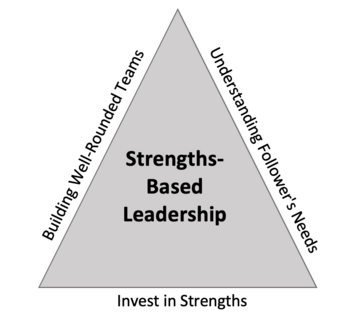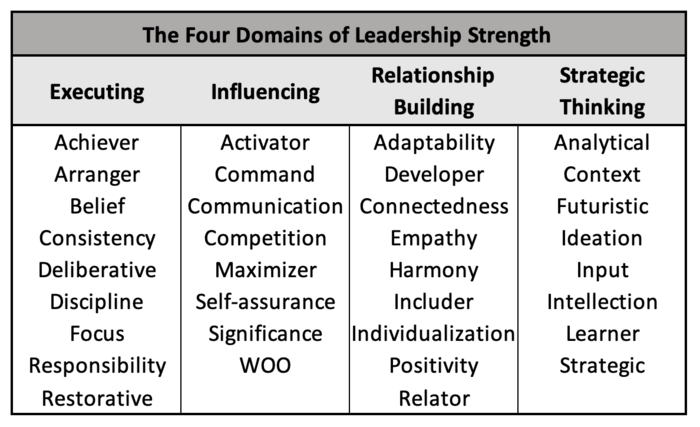Strengths-Based Leadership
Contents |
Abstract
Recent years have brought about a substantial increase in scholarly interest in the strengths-based leadership approach - a specific form of a positive leadership style. Adopting a strengths-based approach has a positive relationship with individuals’ happiness, feeling of purpose, wellness in the workplace, and performance. [1]
According to Rath's and Conchie's research [2], employees' probability of being engaged, when leaders place emphasis on leveraging each team member's distinctive strengths, increases by a factor of eight. That is, compared to a leader that does not value individual strengths. This article covers the three fundamental principles of strengths-based leadership: (1) the most effective leaders consistently invest in strengths, (2) the most effective leaders maximize their team by surrounding themselves with the right individuals, and (3) the most effective leaders have understanding of the needs of their followers. It is argued that by identifying and improving both their own and their team members' strengths, leaders may increase effectiveness and productivity within the team or organization. Additionally, actionable recommendations are made to develop a leadership style that is strengths-based.
Relevance of Strengths-Based Leadership
The English language has several different definitions for the abstract concept of strength. There are several interpretations of the word, and they all conceive a person's strengths in diverse yet related ways. All definitions do, however, acknowledge that strengths are varied, unique, and made up of positive traits, skills, thoughts, behaviours, and resources. When working with individuals in any setting, including employment, education, interpersonal relationships, psychotherapy, and so forth, it is crucial to recognize that strengths are a vital part of the human experience and should therefore be taken into consideration. [3]
Management of projects, programs, and portfolios are important aspects of organizational management that demand strong leadership skills. The leading professional organization for project managers in the world, the Project Management Institute (PMI), is frequently cited as the benchmark for current industry norms. [4] Although the books on project management (PMBOK Guide), [5] program management, [6] and portfolio management [7] do not specifically address strengths-based leadership, they do stress the importance of using approaches to leadership that are in line with the core values of strengths-based leadership.
A competent project manager, according to the PMBOK Guide [5], is one who meets the needs, concerns, and expectations of the project's stakeholders while achieving the objectives of the project. The guide also stresses the significance of cultivating high-performance project teams that may benefit from using strengths-based approaches to leadership. Similarly, the Program Management and Portfolio Management books (REF BÆKUR) underscore the value of managing, involving, and communicating with stakeholders. The managers may improve internal stakeholder performance and engagement by using a strengths-based approach to unlock each individual's and team's potential, leading to enhanced program and portfolio outcomes.
Brief Historical Overview
The "strengths movement" in the organizational and leadership area has roots that go back several decades, with Peter Drucker and Donald Clifton serving as its forerunners in 1967 and the 1990s, respectively. The theory that effective managers concentrate on their team members' strengths rather than their weaknesses was later expanded by Marcus Buckingham and Curt Coffman. Individual strengths are unique and long-lasting, according to both Buckingham and Clifton, and prospects for personal development are greatest in areas of strength. With these claims, two prevailing myths about training programs at the time were challenged: (1) anyone can become proficient at anything with enough effort, and (2) areas of personal weakness offers the most potential for development. The Clifton StrengthsFinder and a six-week program developed for individuals wanting to uncover and employ their strengths was introduced and promoted by the founders of the strengths movement, which made the process of discovering strengths easier. Tom Rath and Barry Conchie formalized the strengths-based leadership theory in 2008, as a result of the expanding body of knowledge regarding the importance of strengths.
Understanding the Theory
By focusing on and consistently increasing individual's strengths, leadership that prioritizes strengths strives to increase an organization's effectiveness, productivity, and success. Organizations that are strengths-based focused put more emphasis on optimizing strengths, rather then eliminating weaknesses. Leaders employing the strengths-based approach, invest in their own strengths as well as their team member's strengths. [8]
Rath and Conchie's strengths-based leadership theory identifies three principles of effective leadership. The principles are demonstrated in Figure 1.

Investing in strengths
Instead of attempting to be excellent in every area, effective leadership requires placing emphasis on strengths. Many organizations seek out leaders who are skilled communicators, visionaries, and executors, but the truth is that no leader can be exceptional in all of these areas. Every leader has a different set of skills and limitations, so understanding the strengths is crucial to become an effective leader. Unfortunately, leaders frequently lack awareness of their own personalities, which causes issues. In addition, research studies have revealed that a considerable number of individuals feel unsatisfied with their lines of work and feel that they are not provided with the opportunity to make the most of their strengths.
Building well-rounded teams

Indicators of high-performing teams
Understanding follower's needs
Application
Key Considerations
Strengths-based leaders recognize the importance of discovering, developing and leveraging their own and their followers' strengths, which improves organizational effectiveness and task performance. When establishing strengths-based leadership, the following suggestions that have been derived from its theory - discussed above - should be noted.
Identifying the leader's strengths
Strength-based leaders should begin with gaining profound understanding of their own distinctive strengths. [1] This may be accomplished through tests such as the StrengthsFinder assessment - now often referred to as StrengthsFinder 2.0 - which evaluates behavioral patterns to identify talent-dominant themes. Additionally, examining a individual's impulsive behaviors, desires, or areas of rapid learning can also identify their strengths.
Understanding the team's strengths
Once an understanding of the leader's strengths have been acquired, assessment of each team member's strengths should be conducted. Here as well, the StrengthsFinder assessment may prove to be helpful. [8]
Assign tasks, according to strengths
Tasks can be delegated in a way that optimizes each individual's skills and performance after the aforementioned steps have been completed. Team members are more engaged and driven to work successfully when assigned tasks that play to their strengths. As a result, the team and the organization as a whole perform better, are more productive, and are more satisfied at work. Strengths-based development should be encouraged going forward in light of these advantages. [1]
Promote a strengths-based culture
Organizations that seek to foster strength-based leadership must encourage a strengths-based culture. As a result, it's crucial to match the organization's performance management philosophy with the strengths-based culture. During performance evaluations, managers should support their team members' strengths and offer rewards and opportunities for growth that are consistent with their strengths. Employees will feel appreciated and respected if they are given clear performance standards and goals to work toward.
Moreover, leaders that use a strengths-based approach have the following main approaches for addressing employees' weaknesses: (1) altering a role to suit the individual rather than the other way around, (2) enabling staff to seek assistance from those with favorable strengths, and (3) reassigning a person if their core abilities are not a fit for the role's essential criteria.
Having managers that are intrinsically suited for the position can make a difference in bringing a strengths culture to life. These managers should be enthused by supporting others develop their strengths and have an interest in how different individuals function. Furthermore, having experienced strengths coach may be valuable for organizations. Human resources professionals who have a passion to coach and the coaching ability may become experts in strengths, coaching workers and ensuring they play to their strengths at work every day. The most effective managers assemble teams with a strategic purpose, based on personal and team preferences, rather than hastily assemble the teams. [9]
Annotated Bibliography
Gallup, Rath, T., & Conchie, B. (2008). Strengths Based Leadership: Great Leaders, Teams, and Why People Follow. Simon and Schuster.
The strengths-based leadership approach, which places a strong emphasis on acknowledging and using team and individual strengths to improve organizational performance, is thoroughly explained in this book. The authors explore the key components of strengths-based leadership, such as the significance of focusing on individual's strengths, creating an encouraging work environment, and establishing strong relationships with team members, by drawing on extensive research by Gallup and real-world experience. Along with strategies for implementing these newfound insights to use to increase leadership effectiveness, the book also includes a thorough assessment tool, the StrengthsFinder, for identifying personal and team strengths. For those looking to understand and incorporate strengths-based leadership principles into their own leadership practices, this book is a must-read.
Pearce, R. (2018). Be a Project Motivator: Unlock the Secrets of Strengths-Based Project Management (1st ed.). Berrett-Koehler Publishers.
Project managers are provided with guidelines for incorporating strengths-based approaches and positive psychology into their projects in this book by R. Pearce. The book demonstrates how team strengths can be identified and used to increase productivity and the likelihood of project success through the use of practical examples. The author highlights the importance of being a project motivator and offers practical strategies for fully making use of team strengths. The book also offers suggestions for avoiding common pitfalls as well as insightful information about potential difficulties that might arise when strengths are prioritized. In general, this book is an invaluable tool for project managers who want to foster an encouraging and productive workplace environment.
References
Citation
- ↑ 1.0 1.1 1.2 Ding, H., Yu, E., & Li, Y. (2020). Strengths-based leadership and its impact on task performance: A preliminary study. South African Journal of Business Management, 51(1). https://doi.org/10.4102/sajbm.v51i1.1832
- ↑ 2.0 2.1 Gallup, Rath, T., & Conchie, B. (2008). Strengths Based Leadership: Great Leaders, Teams, and Why People Follow. Simon and Schuster.
- ↑ Simmons, C., PhD, & Lehmann, P. (2013).Tools for Strengths-Based Assessment and Evaluation. Springer Publishing Company.
- ↑ Pearce, R. (2018). Be a Project Motivator: Unlock the Secrets of Strengths-Based Project Management (1st ed.). Berrett-Koehler Publishers.
- ↑ 5.0 5.1 Project Management Institute. (2021). A Guide to the Project Management Body of Knowledge (PMBOK Guide) (7th ed.).
- ↑ Project Management Institute. (2017). The Standard for Program Management (4th ed.).
- ↑ Project Management Institute. (2017). The Standard for Portfolio Management (4th ed.).
- ↑ 8.0 8.1 8.2 Burkus, D. (2011). Building the Strong Organization: Exploring the Role of Organizational Design in Strengths-Based Leadership. Journal of Strategic Leadership, 3(1).
- ↑ Flade, P., Asplund, J., & Elliot, G. (2015, October 8). Employees Who Use Their Strengths Outperform Those Who Don't. Gallup.